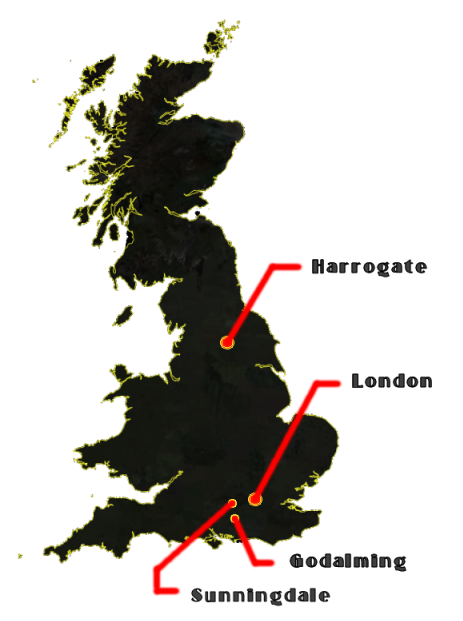Agatha's Disappearance
The Culmination
A few life-changing events for Agatha Christie led up to her famous disappearance of December 3, 1926. Earlier that year, Agatha's mother Clara Miller had passed away after a terrible bout of bronchitis. Agatha's husband Archie Christie had been away in Spain when she had been ill, and as Archie hated "illness, death, and trouble", promptly went away to London leaving Agatha to deal with her mother's death. Clearly it was difficult to clear the family home of Ashfield, where Mrs. Miller had died, because Agatha had so many wonderful memories there. No doubt Agatha was physically and emotionally drained. She described that time as a period of loneliness (she didn't receive any support from Archie or any visits from him) and started letting little things confuse her, getting her mind all muddled. She started having glimpses of a nervous breakdown then: she would burst into tears simply for her car not starting, or having trouble remembering her own name when signing a check.
Agatha received some relief when The Murder of Roger Ackroyd was released that year in June. It had brought her great critical acclaim, especially great because it was her first published book with a new publisher, William Collins Sons & Co. The book catapulted her into the literary stratosphere. She, too, was able to return to hers and Archie's home of Styles, but then a greater blow was dealt to her.
Archie had announced to Agatha that he was in love with another woman, a Nancy Neele, former secretary of Major Belcher's (from the Christies' world tour days). He then proceeded to demand a divorce right away. They had separated, but Archie returned to Styles for a "trial reconciliation", of which Agatha described as a "mistake . . . a period of sorrow, misery, heartbreak." In the late summer through the fall of 1926, Agatha wasn't in the proper shape to write a new book. Her brother-in-law Campbell Christie suggested that she take the short stories printed in the Sketch magazine and fill in the gaps between each story with narration. This produced the Captain Hastings-narrated novel "The Big Four", later released in 1927.
The Disappearance
As the facts go, December 3 (a Friday) Agatha was probably still on her way to a nervous breakdown. That very day, Archie told her he was leaving her finally (he had packed his bags in the day, during her absence from Styles House). He had been invited to Godalming for the weekend by some friends (where his lover Miss Neele was apparently waiting for him). Christie biographer Gwen Robyns discusses the disappearance in her book The Mystery of Agatha Christie. In her biography, Mrs. Robyns said the party at Mr. and Mrs. James' house was to be an engagement party. Presumably this was a good excuse and way for Archie to leave Agatha behind.
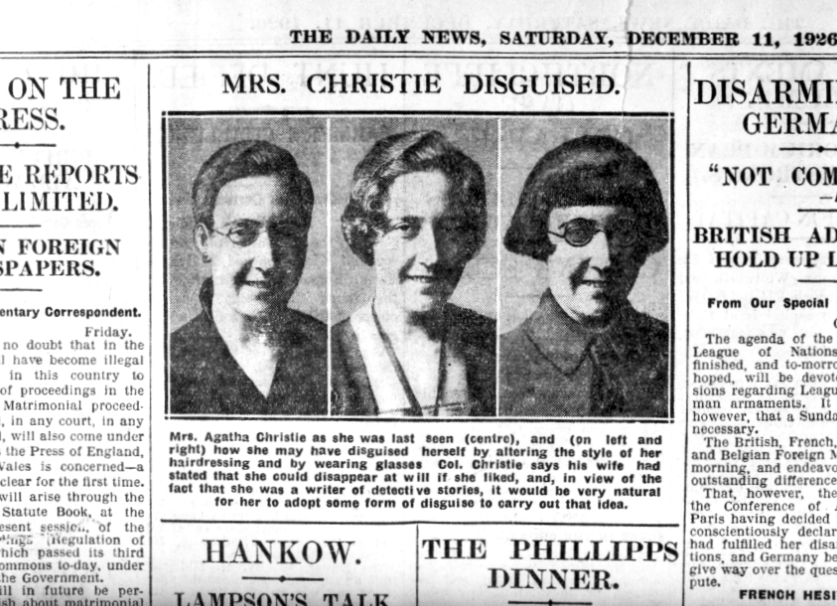
The Daily News' coverage on the 7th day of Christie's disappearance. What she would've looked like had she disguised herself.
After having arrived home, she learned that Archie had already left. Around 9:45 that evening, she left Styles in her car after having packed a small suitcase and taking it with her. The following morning, Saturday, December the 4th, Agatha's car was found over an embankment of a lake (Silent Pool) at Newlands Corner, in Surrey, with the hood up and the lights on. Inside her green Morris Cowley, left behind were her fur coat, the suitcase with her belongings, and an expired driver's license. Agatha's disappearance became national news when the Surrey police issued a missing persons report. It was said that 500 policemen in four counties were searching for Agatha, and an award of one hundred pounds was offered for information leading to her recovery. Scouts, bloodhounds, airplanes, and divers were combing the entire countryside for her. In total, an additional 15,000 volunteers searched for her. Fellow mystery writers Sir Arthur Conan Doyle and Dorothy L. Sayers volunteered their help. Sayers searched the countryside for clues (to no avail) and Doyle took a glove of Agatha's to a medium (but that didn't help).
Various facts/accounts add to the entire story of Agatha's 11-day disappearance. These are found in either books or on the Internet. In The World of Agatha Christie, Martin Fido says that the evening Agatha left she wrote a letter to Carlo Fisher (her secretary) asking to cancel reservations for lodgings in Yorkshire. Not only that, but she wrote a scathing letter to Archie, which he burned. Fido also says Saturday morning (before the discovery of her abandoned Morris) Agatha mailed off a letter to Campbell Christie from London (saying she was going to Yorkshire). He received it on Monday, but it was then lost before he could read it. Obviously, that letter could have resulted in Agatha's discovery before the public knew of her disappearance. In Sanders and Lovallo's The Agatha Christie Companion, we find that Miss Fisher called Archie at the James house, probably to warn him that Agatha was coming to confront him and Miss Neele. This asserts the belief that Archie planned to leave the James house during dinner to try to meet her outside to prevent a confrontation. It seems in other accounts that Archie did not hear about her leaving Styles House (and the disappearance) until the next morning. According to Altered Dimensions.net, yet another note was written to the Deputy Chief Constable of Surrey Police which notified him that she feared for her own safety. Altered Dimensions does affirm the fact (in Fido's book) that Agatha planned to get away and relax in Yorkshire.
The Discovery
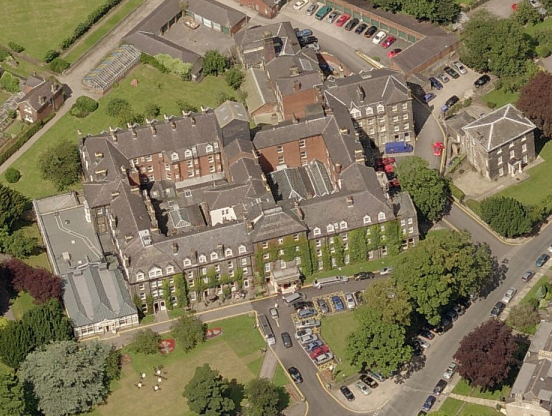
The Old Swan Hotel (formerly known as the Hydropathic Hotel) is off Swan Road in Harrogate, North Yorkshire.
Agatha had been missing for 11 days since that Saturday morning. After dredging the lake, flying planes overhead (the first time that had been done in England for missing persons), and countless hours of searching, Agatha was discovered in almost an anticlimactic place and way. Police had learned that she was staying as a guest at a posh spa resort, the Hydropathic Hotel (now the Old Swan) in Harrogate. She had arrived by taxi on December 4, carrying only what it seemed to be a small suitcase. In his book, Fido says she took the train from London to Harrogate. That would make sense: 1) Campbell's letter was postmarked from London, 2) obviously Agatha's car was left on a small lane about 5 miles out of Godalming. The distance between London and Harrogate is roughly 210 miles, excluding the distance from Godalming to London (some 40 miles more); it would then make sense Agatha took the train. The question of money on her person had been asked. She was known to wear a money belt with her, but more on that later.
Agatha checked into the hotel as a "Mrs. Teresa Neele of Cape Town" (using Archie's lover's surname) and explained to everyone there she was a bereaved mother recently arrived. She was seen dancing the Charleston, playing bridge, doing crosswords, and reading the newspapers. Curiously, she placed an advertisement in The Times, asking "Friends and relatives of Teresa Neele, late of South Africa, please communicate.--Write Box R 702, The Times, EC4." There are several accounts of who recognized/reported Agatha Christie as a guest of the hotel. Sanders and Lovallo state that one Bob Tappin (a musician with the band at the hotel) claimed the 100 pound reward when he recognized the author Christie and reported the news to the police. Mr. Fido reports that a chambermaid at the hotel realized there was a similarity between Mrs. Christie and Mrs. Neele; she told two band players her idea (supposedly, one of them being Mr. Tappin). A young journalist by name of Peter Ritchie-Calder (to later become a well-known academic and author) had deduced Agatha would be in Harrogate and went ahead of the police and press to confront Christie. He addressed her as "Mrs. Christie", which she acknowledged to him but told him that she had been suffering from amnesia. Police and the press brought along Archie Christie for him to identify her positively, although at first she recognized her husband as her brother. He met with her privately there, and emerged with the news that she had suffered "the most complete loss of memory and does not know who she is."
The Theories
There were three theories abounding around the whole disappearing act. It could've been: 1) a publicity stunt to increase her sales (The Murder of Roger Ackroyd was still on the best-seller lists), 2) an act of revenge towards Archie for the way he treated Agatha (he could've been arrested, tried for her murder or certainly it was a way to embarass him and paint a bad picture of him for the public to see), or 3) a genuine event in which she did lose her memory from an automobile accident.
Doctors were consulted, police were involved, reporters were hypothesizing. The doctors said that she did have amnesia and asked that people spare her more anxiety. Police were leaning towards the revenge theory or thinking that it was a well-planned stunt. Reporters agreed with the police; they refused to believe the nonsense theory of memory loss. They pointed out a few irregularities in her claim of amnesia. One was the fact that she was found carrying a money belt (hotel guests noticed she had a large amount of money with her)--why would she be carrying money with her if she was just going to confront Archie at the James house? (She said she always carried the money belt for emergencies.) Another point against the loss of memory idea was while she was at Harrogate, the author wrote to Harrods department store asking about a diamond ring she had lost there. However, that ring in question was lost at the store one week prior to her disappearance! She even described the ring perfectly and asked the store to send the ring to a Mrs. Teresa Neele at the Hydro Hotel in Harrogate; it was duly found there and returned to her, while she was still at the hotel. (A big blow to this story, though, is that Harrods has no record of this so-called letter. Hmm...what does the Hydro Hotel say in this matter of the ring?)
In his book Agatha Christie and the Eleven Missing Days (1999), author Jared Cade interviewed family members of James Watts (who married Agatha's sister Madge) and they did reveal that the elaborate disappearance was all planned to spite Archie. James Watts' sister Nan supplied Agatha cash for new clothes and train fare. (Supposedly tucked away in that money belt!) I'm sure the newshounds felt proud that they were right, that it was indeed a hoax to embarass or punish Archie Christie.
The Interpretations
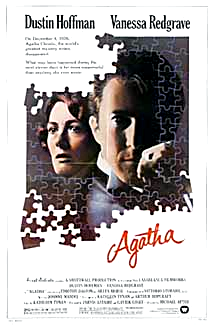
Vanessa Redgrave starred as Agatha Christie and Dustin Hoffman is Wally Stanton, an American reporter in the 1979 film Agatha.
Agatha was a 1979 film from Warner Brothers that provides fictional speculation of the events of Christie's disappearance. The film is based on the 1978 novel Agatha, written by Canadian-British journalist Kathleen Tynan. Her novel answers questions of how Agatha reacted when Archie decided to leave her--for good--for a younger woman. We follow Agatha (in the novel as well as in the film) as she travels to the hotel in Harrogate. There she meets an American journalist Wally Stanton who falls in love with her. They do share a brief romantic encounter while he helps her overcome her husband's loss and her suicidal thoughts. Some critics say that the Hoffman character of Stanton is all wrong, not to mention Christie contemplating suicide. That goes against everything that Christie was as a person--she believed suicide was morally wrong. Archie adamantly repeated that again and again during the search. Tynan offers in her novel Agatha the hypothetical scenario: what would Christie do to herself after her nervous breakdown? Does she plan her own disappearance to rid herself of the young Miss Neele? Does Agatha become a vengeful or vindictive person? Mrs. Tynan, in preparation for her novel, did her own detective work and research (which included findings at the British Museum).
There is a fanciful solution of Agatha's memory loss, by way of the BBC long-running science fiction TV show Doctor Who. Writer Gareth Roberts proposes that an alien wasp had threatened Agatha's life and had drowned in the Silent Pool; so traumatic was this event that Agatha lost her memory. The character of the Doctor takes the shaken up Agatha Christie to the hotel in Harrogate to recuperate, and thus leaves her. The Doctor, however, believes that her amnesia was not total, for Agatha remembers still the wasp/alien. Fenella Woolgar was fantastic in her portrayal of Christie--down to her shyness in front of people. It was at the behest of David Tennant's (who portrays the Doctor) that Woolgar be cast as Agatha Christie.

Fenella Woolgar (right) appeared as Agatha Christie in the Doctor Who episode "The Unicorn and the Wasp" (2008). Suspects were included as if Christie had written the story: the colonel, the hostess, the vicar, and the socialite.
A "what-if" movie of Agatha's 11-day disappearance premiered on Channel 5 in the UK (December of 2018). It was titled Agatha and the Truth of Murder and was about Agatha getting involved in solving a murder during the same period of time of her disappearance. The movie explains what Agatha was doing in those missing 11 days. That's the "what-if" or the speculation. While her marriage is in turmoil with husband Archie, Agatha is approached by a woman asking for help solving a murder that transpired on a train. Agatha disguises herself as a representative of a law firm and calls herself Mary Westmacott. Odd choice for a name--that was the actual pseudonym Agatha chose when she published her six "romance" novels from 1930-1956. I wondered why she chose this name instead of Teresa Neele, the name she used when checking into the Hydropathic Hotel. Maybe in the movie she did change it to Neele. I wouldn't know, for I didn't finish watching the movie. I could only watch thirty minutes of it. It bored me tremendously and I thought it absurd that a stranger would barge into Agatha's life asking her to solve a murder. Agatha didn't want to initially, telling the woman (Mabel Rogers): "I'm sorry, Miss Rogers, but whatever fantasy you've been indulging, I'm a writer, not a detective." Besides being a writer, not a sleuth, she was mother to Rosalind and was trying to mend her marriage to Archie. The best bits of what I saw in the movie was the scenes/interactions with her daughter and husband. The acting was fine and actress Ruth Bradley did a fine job portraying Agatha Christie.
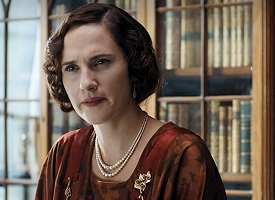
Irish actress Ruth Bradley portrays Agatha Christie in the television movie Agatha and the Truth of Murder (2018).
An intriguing addition to the speculation of the 11-day disappearance is Carole Owens' book The Lost Days of Agatha Christie (1996). Dr. Carole Owens is a practicing psychotherapist who pretends to take on Agatha Christie as a patient of her own. In the book, Dr. Owens' goal is to diagnose Christie's problem and then solve the mystery of the disappearance. Owens guesses that Agatha ditches (pun intended) her car at Silent Pool and walks to the village of Guildford (which is close), and takes the train to London from the Guildford Railway Station. Owens says that amnesia is the excuse easily taken by Agatha because it is a method of running away from adversity. She concludes that Agatha didn't suffer amnesia, because she remembered Archie's lover's last name being Neele. Owens quotes Agatha as "saying": "I would do anything to stop Archie. Anything. It is logical. Logic tells us that is who I was in 1926 and I created a scandal to, to . . . something. To have my way, then forget the kind of person I was." I myself suppose Owens says that Agatha Christie wanted to forget the death of her mother and Archie Christie leaving her behind, and the way to do that is feigning amnesia.
For further reading, an excellent retelling and analysis of Agatha Christie's 11-day disappearance can be found at the Sexual Fables site, article titled Poison Pen Letters.
